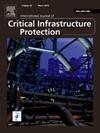Vulnerability assessment of interdependent road-power networks with probability-based coupling strategies
IF 5.3
3区 工程技术
Q1 COMPUTER SCIENCE, INFORMATION SYSTEMS
International Journal of Critical Infrastructure Protection
Pub Date : 2025-08-12
DOI:10.1016/j.ijcip.2025.100792
引用次数: 0
Abstract
The road network and power grid are vital components of urban infrastructures, but their interdependence significantly amplifies vulnerability. Thus, this paper studies the vulnerability of the interdependent road-power network constructed by a probability-based coupling strategies. First, the road network and the power grid are abstracted as two single networks, respectively, where user equilibrium and the Kirchhoff’s law are used to construct the cascading failure model. Then, to establish an effective interdependent relationship between them, we propose ranking proportion reflecting the ranking of a node in the single network and construct the interdependent link between networks through the probability determined by the difference of ranking proportion, thereby developing a probability-based framework for generating coupling strategies. This can produce coupling strategies with a specific assortativity coefficient based on various kinds of metrics. Finally, we use the real-world Shanghai road network and the IEEE 118-node power grid to conduct a case study on the vulnerability of the interdependent network with sixteen assortative and disassortative coupling strategies obtained by the proposed framework with four topological and functional metrics. Experimental results show that under intentional attacks, the interdependent network with disassortative coupling strategies regarding fluctuations of power loads exhibits slight vulnerability; under random failures, disassortative coupling strategies regarding the power load mitigate its vulnerability. In addition, there is little difference in the vulnerability of the interdependent network with assortative coupling strategies regardless of attack strategies. Besides, its vulnerability is more significant while adopting coupling strategies regarding classic topological metrics.
基于概率耦合策略的道路电力网络脆弱性评估
道路网络和电网是城市基础设施的重要组成部分,但它们之间的相互依赖性大大增加了脆弱性。因此,本文研究了基于概率耦合策略构建的相互依赖道路-电力网络的脆弱性。首先,将路网和电网分别抽象为两个单独的网络,利用用户均衡和基尔霍夫定律构建级联故障模型;然后,为了建立它们之间有效的相互依赖关系,我们提出了反映单个网络中节点排名的排名比例,并通过排名比例差异决定的概率来构建网络之间的相互依赖联系,从而开发了基于概率的耦合策略生成框架。这可以产生基于各种度量的具有特定选型系数的耦合策略。最后,以现实世界的上海道路网络和IEEE 118节点电网为例,对基于4个拓扑和功能指标的框架所获得的16种分类和非分类耦合策略进行了脆弱性分析。实验结果表明,在故意攻击下,基于电力负荷波动的非分类耦合策略的相互依赖网络表现出轻微的脆弱性;在随机故障情况下,针对电力负荷的非分类耦合策略可以降低其脆弱性。此外,无论攻击策略如何,分类耦合策略下的相互依赖网络的脆弱性差异不大。此外,针对经典拓扑指标采用耦合策略时,其脆弱性更为显著。
本文章由计算机程序翻译,如有差异,请以英文原文为准。
求助全文
约1分钟内获得全文
求助全文
来源期刊

International Journal of Critical Infrastructure Protection
COMPUTER SCIENCE, INFORMATION SYSTEMS-ENGINEERING, MULTIDISCIPLINARY
CiteScore
8.90
自引率
5.60%
发文量
46
审稿时长
>12 weeks
期刊介绍:
The International Journal of Critical Infrastructure Protection (IJCIP) was launched in 2008, with the primary aim of publishing scholarly papers of the highest quality in all areas of critical infrastructure protection. Of particular interest are articles that weave science, technology, law and policy to craft sophisticated yet practical solutions for securing assets in the various critical infrastructure sectors. These critical infrastructure sectors include: information technology, telecommunications, energy, banking and finance, transportation systems, chemicals, critical manufacturing, agriculture and food, defense industrial base, public health and health care, national monuments and icons, drinking water and water treatment systems, commercial facilities, dams, emergency services, nuclear reactors, materials and waste, postal and shipping, and government facilities. Protecting and ensuring the continuity of operation of critical infrastructure assets are vital to national security, public health and safety, economic vitality, and societal wellbeing.
The scope of the journal includes, but is not limited to:
1. Analysis of security challenges that are unique or common to the various infrastructure sectors.
2. Identification of core security principles and techniques that can be applied to critical infrastructure protection.
3. Elucidation of the dependencies and interdependencies existing between infrastructure sectors and techniques for mitigating the devastating effects of cascading failures.
4. Creation of sophisticated, yet practical, solutions, for critical infrastructure protection that involve mathematical, scientific and engineering techniques, economic and social science methods, and/or legal and public policy constructs.
 求助内容:
求助内容: 应助结果提醒方式:
应助结果提醒方式:


